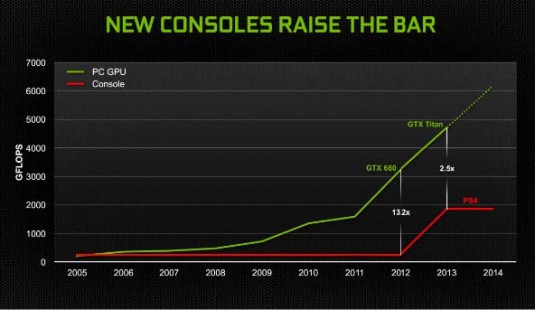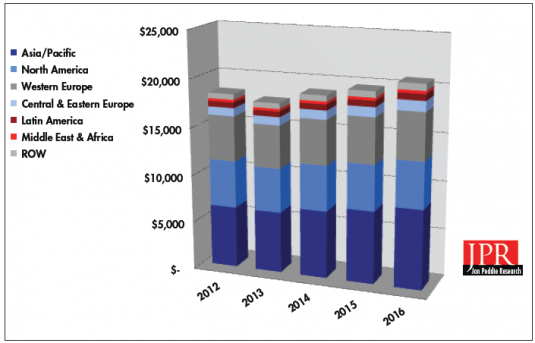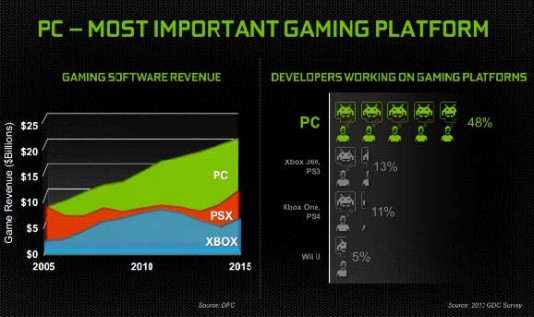Filling the vacuum left by so few details being released about new consoles.
By Robert Dow
In the absence of much talk about the actual hardware inside the new Xbox One and PlayStation 4 at the recent E3 Conference, Nvidia took the opportunity to talk about the dominant processing power of the PC.
You never have to tell anyone at Jon Peddie Research how dominant the PC is from a hardware standpoint, so it was good to see PC gaming getting some play time at a conference all about consoles and mobile.

Tony Tamasi, Nvidia’s Senior VP of Content and Technology, remarked, “PC gaming is the best gaming experience right now, and that won’t change even with next-generation consoles launching. The PC is the best visual experience, I do not think anyone could argue that, but it is a different experience—lean-forward games as opposed to the lean-back games. Titan boasts a 2.5 times performance advantage over the PlayStation 4 and Xbox One, and that gap will only continue to grow. Not to mention that consoles still haven’t solved anti-aliasing. This also gives the PC a visual advantage.”
PS4 and Xbox One are eight times more powerful than last-generation consoles. Given that the bar has been raised for consoles, PC games should see a much more powerful gaming experience in the upcoming year; games will only increase in their use of graphics performance. “Developers,” Tamasi added, “can now build really awesome content that can then scale to the PC.” Another factor that should help game developers is the similar architecture the new consoles and PCs now share.
Frank Gibeau, President of EA Labels, addressed this in EA’s shareholders conference call, pointing out, “Last time around, the two platforms were radically different, very different architectures on Sony and Microsoft. We had to do a lot of rework between the two in order to get product out simultaneously. So there was a lot of incremental cost to get a 360 and a PS3 game out. Now the architectures are more alike than different underneath the hood. Now they do very different things with them. But at the core, using Ignite and Frostbite, we’re able to gain a lot of efficiencies based on having the architecture being more similar than different.”
The future for gaming on the PC looks promising with Nvidia projecting gaming software revenue will hit $20 billion by 2015. At JPR we are projecting PC, AIB purchases, and accessories worldwide to hit $18.3 billion dollars this year, growing to $23 billion by 2016.

Tamasi said that “the PC is the most powerful gaming platform out there.” And it is here to stay.
Our take
No one can argue the PC is not technically and graphically superior to console gaming and mobile, and always will be. The PC is a dynamic platform in OS, processors, and especially graphics, while the console remains static and mobile devices cannot compete visually with the PC—there’s just not enough real estate. One challenge facing PC gaming in recruiting new gamers is with the peripherals. We are told that “touch” is bringing more people into gaming because it is intuitive. The learning curve to play a touch-based game is minimal. For PC gaming, it is the polar opposite: there is nothing intuitive about tapping “F” to pick up a grenade or “space bar” to knock in a door to frag a zombie on the other side.
You can play a touch game with one finger, a console pad takes six at most, a PC game requires both hands working together; it is hard work mastering a PC. Children grow up with game pads in their hands; it’s probably the third piece of hardware a child touches after a pacifier and bottle. By the time a child is ten, he or she has probably saved the princess, the planet Hyrule, and the entire galaxy a few hundred times, all with help from nothing save the trusty gamepad; making a transition to the keyboard and mouse is unappealing. I’d love to see next-generation games incorporate true responsive gamepads. I know you can use an Xbox gamepad now on most games, but it is an extra step in setup, it is glitchy, and PC gamers always complain about the lack of responsiveness and aiming accuracy— nothing is quicker than a mouse and keyboard when it comes to zeroing in on opponents. Those who have mastered a keyboard and mouse in PC gaming have a distinct advantage. The learning time to master the peripherals of PC gaming, although rewarding in the end, can be intimidating to new gamers. It would be good to see the industry make it easier if possible.






